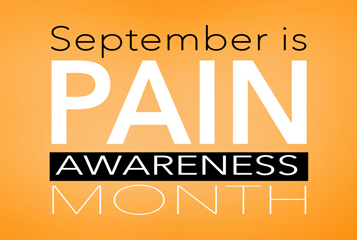
According to the International Association for the Study of Pain (IASP), pain is an annoying sensation and emotional experience that is associated with actual or potential damage of tissue. It is a personal feeling that is affected to varying degrees by social, psychological, and biological factors. For every person the way they feel and describe pain varies. Pain can be long-term or short-term, and can remain in one place or spread the whole body.
Pain awareness month was the development as a part of Pain Awareness Campaign launched by the American Chronic Pain Association. As a part of pain awareness month, The U.S PAIN FOUNDATION has given a theme for the year 2020 which is called “MyPlainPlan”. It will concentrate on the need for a personalized approach to pain treatment involving physicians from different medical disciplines, and the barriers patients are facing in getting this kind of care. The foundation is offering new resources and tools to people with pain throughout the month. It includes the launch of MyPainPlan.org, that will help users learn about a wide range of treatment options and choose any of them to add to their customized plan, free online events, a survey report, a social media campaign, and heating pad giveaways.
This pain awareness month the focus will be on raising awareness about the different types of pain and pain management. It will help improve the treatment and also reduce pain-related suffering.
The different types of pain are:
- Acute Pain: It often begins immediately and feels sharp. It is caused by something specific. It usually does not stay more than six months. Acute pain is temporary pain that goes away if there is no underlying cause for the pain. The typical causes are labor pain, surgery, accidentally touching a hot stove, etc. If the acute pain is not relieved, it can transform to chronic pain.
The different types of acute pain include:
- Somatic pain: It normally feels like a constant aching on the skin.
- Visceral Pain: It refers to the pain in the body – in the lungs, heart, pelvic, and abdominal organs.
- Referred pain: It is the pain that is felt from an internal organ in a different part of the body, that means if the liver is enlarged it leads to pain in the right shoulder. It happens because the pain messages that the liver generates travel along the same nerve route that is taken by messages from the skin. Due to this, the brain is confused and think that the pain is arriving from a different location.
- Chronic Pain: It is the pain that generally lasts longer than six months even after the original injury has healed. It can last for years and the pain scale can change from mild to severe. If proper care is not given, it can affect the quality of the person’s life. Arthritis pain, low back pain, migraines etc are examples of chronic pain.
- Neuropathic pain: When the peripheral nerves that link the brain and spinal cord are injured, this pain occurs. It can cause tenderness, discomfort, numbness, or tingling. It feels like an electric shock.
- Central Pain: This pain is typically due to bleeding in the brain or spinal cord, or due to tumors, degeneration, infarction, and abscesses. This pain is ongoing and can scale from mild to very painful. Aching, pressing sensations, and burning are reported by people who experience central pain.
- Phantom Pain: It is the pain that originates from a missing body part, that means it occurs after amputation of a limb. Earlier, doctors believed that this is a psychological issue, but experts now recognize that it is occurring in the spinal cord and brain.
Pain Management and Treatment
For different types of pain, the treatment may vary to ensure effective results. It is always important to have medicines and follow the exact dosage that is prescribed by the doctor.
- Acute Pain Treatment: For acute pain treatment, proper medications are needed. They are:
- Nonsteroidal anti-inflammatories (NSAIDs): It is a type of analgesic or pain reliever that can help a person regain daily-function. This is suitable for acute pain like backaches, headaches, and that caused by light sprains. It reduces localized inflammation and pain due to swelling. It may have side effects that affect the digestive system, including bleeding. Persons who are prescribed a high dosage will be monitored by the doctor.
- Opioids: For extreme acute pain, that is the pain following surgery, cancer, bone fractures, and burns, doctors prescribe opioids. These are highly addictive, and give rise to withdrawal symptoms, and lose effectiveness over time.
- Chronic Pain Treatment: There are nondrug therapies available for people experiencing chronic pain. The following therapies are alternative to medications:
- Psychotherapy
- Acupuncture
- Nerve blocks
- Relaxation techniques and exercises
- Surgery
- Rest
So, understand the pain cause by continuously monitoring the pain, consult a doctor if you notice something out of the ordinary. That means, if you feel a pain that cannot be managed and that shouldn’t be happening, seeing a doctor will help you receive the right treatment at the right time. Doctors use pain scale tools to assess a person’s pain, which help to measure the intensity of pain experienced. Pain scale tools help determine the severity, type, and duration of pain.
With a better understanding of pain using the tools, doctors can make an accurate diagnosis, plan a treatment schedule, and have an understanding about the effectiveness of the treatment. During this pain awareness month, understand the types of pain and follow the correct treatment for pain management. It will help reduce the severity of the pain by avoiding the transformation of acute pain into chronic pain, enable you to get back to your daily activities and improve the quality of your life.
